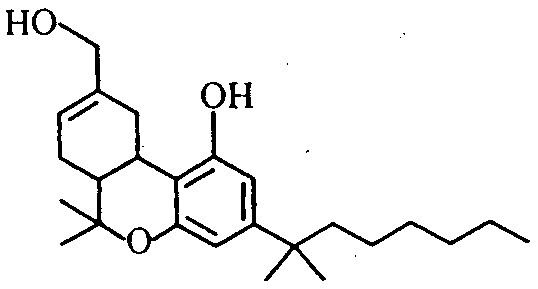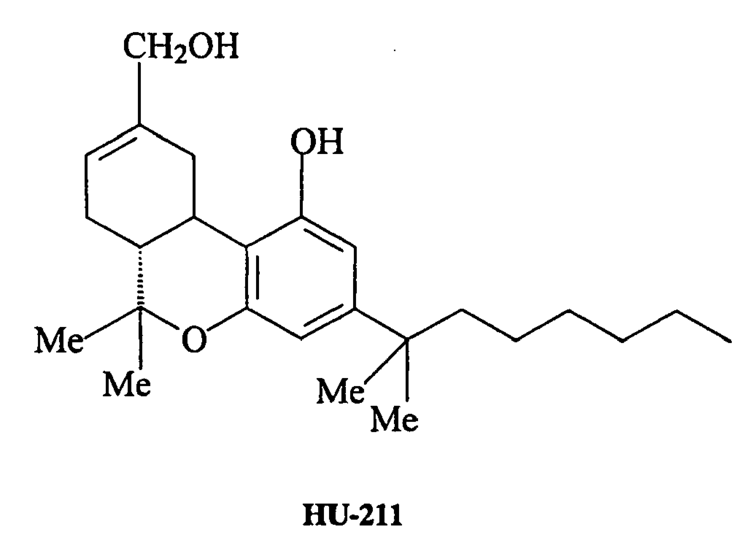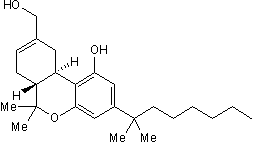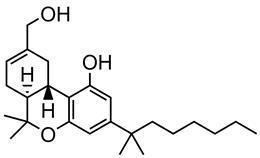CAS Number 112830-95-2 IUPHAR/BPS 731 Molar mass 386.567 g/mol | PubChem CID 9821569 ChemSpider 7997318 | |
 | ||
Legal status CA: Schedule IIUS: Unscheduled Synonyms 1,1-Dimethylheptyl- 11-hydroxy- tetrahydrocannabinol | ||
HU-210 is a synthetic cannabinoid that was first synthesized in 1988 from (1R,5S)-myrtenol by a group led by Professor Raphael Mechoulam at the Hebrew University. HU-210 is 100 to 800 times more potent than natural THC from cannabis and has an extended duration of action. HU-210 is the (–)-1,1-dimethylheptyl analog of 11-hydroxy- Δ8- tetrahydrocannabinol; in some references it is called 1,1-dimethylheptyl- 11-hydroxytetrahydrocannabinol. The abbreviation "HU" stands for Hebrew University.
Contents
- Effects and research
- Chemistry
- Recreational use
- Legal status
- New Zealand
- United States
- Alabama
- Florida
- Vermont
- References

Effects and research

The (+) enantiomer of HU-210 has almost all of the cannabinoid activity, with the (−) enantiomer HU-211 being inactive as a cannabinoid but instead acting as an NMDA antagonist having neuroprotective effects.

HU-210 promotes proliferation, but not differentiation, of cultured embryonic hippocampal neural stem and progenitor cells likely via a sequential activation of CB1 receptors, Gi/o proteins, and ERK signaling. It was also indicated by this increased neural growth to entail antianxiety and antidepressant effects.

HU-210, alongside other synthetic cannabinoids like WIN 55,212-2 and JWH-133, is implicated in preventing the inflammation caused by amyloid beta proteins involved in Alzheimer's disease, in addition to preventing cognitive impairment and loss of neuronal markers. This anti-inflammatory action is induced through the activation of cannabinoid receptors, which prevents microglial activation that elicits the inflammation. In addition, cannabinoids completely abolish neurotoxicity related to microglia activation in rat models.
HU-210 is a potent analgesic with many of the same effects as natural THC.
Chemistry

HU-210 is the enantiomer of HU-211 (Dexanabinol). The original synthesis of HU-210 is based on an acid-catalyzed condensation of (–)-Myrtenol and 1,1-Dimethylheptylresorcinol (3,5-Dihydroxy-1-(1,1-dimethylheptyl)benzol).
Recreational use

According to the U.S. Customs and Border Protection, HU-210 was discovered in Spice Gold incense products seized at the US border in January 2009. Over 100 pounds (45 kg) of Spice products were seized based on this finding. HU-210 was also detected in three Spice products in the UK, as reported in June 2009.
Legal status

HU-210 is not listed in the schedules set out by the United Nations' Single Convention on Narcotic Drugs from 1961 nor their Convention on Psychotropic Substances from 1971, so the signatory countries to these international drug control treaties are not required by said treaties to control HU-210.
New Zealand
HU-210 is banned in New Zealand as of 8 May 2014.
United States

HU-210 is not listed in the list of scheduled controlled substances in the USA. It is therefore not scheduled at the federal level in the United States, but it is possible that HU-210 could legally be considered an analog of Delta-8-THC (which is one of the substances controlled in Schedule I as "tetrahydrocannabinols"), and therefore sales or possession could potentially be prosecuted under the Federal Analogue Act. A brief profile of HU-210 written and published by the Drug Enforcement Administration (DEA) in 2009 (but subsequently removed from the DEA's website several years later) stated that HU-210 is a Schedule I controlled substance under the Controlled Substances Act due to being similar to THC. This indicates that the DEA might legally consider HU-210 to be an analogue of Delta-8-THC for the purposes of applying the Federal Analog Act to those that handle HU-210. An elucidation of the rational for the DEA's claim was not presented, no references were cited, and the claim was eventually removed from the DEA's website. A version of the document (updated in 2013), now in PDF form, exists on the DEA Office of Diversion Control's website. Claimed in this possibly misleading though definitive sounding document, with the same lack of detailed explanation or citation, is:
Alabama
HU-210 is a Schedule I controlled substance in Alabama.

(4)a. A synthetic controlled substance that is any material, mixture, or preparation that contains any quantity of the following chemical compounds, their salts, isomers and salts of isomers, unless specifically excepted, whenever the existence of these salts, isomers and salts of isomers is possible within the specific chemical designation or compound:
... 9. (6aR, 10aR)-9-(hydroxymethyl)-6,6-dimethyl-3-(2-methyloctan-2-yl)-6a,7,10,10a-tetrahydrobenzo[c]chromen-1-ol, some trade or other names: HU-210.
Florida

HU-210 is a Schedule I controlled substance, categorized as a hallucinogen, making it illegal to buy, sell, or possess in the state of Florida without a license.
Vermont
Effective January 1, 2016, HU-210 is a regulated drug in Vermont designated as a "Hallucinogenic Drug."
“Hallucinogenic Drug” means those specified in Section 7 of this rule including stramonium, mescaline or peyote, lysergic acid diethylamide, and psilocybin, and all synthetic equivalents of chemicals contained in resinous extractives of Cannabis sativa, or any salts or derivatives or compounds of any preparations or mixtures thereof, and any other substance having a hallucinogenic effect in the regulations adopted by the Board of Health under 18 V.S.A.§ 4202.
...
• Cannabimimetic Agents means, collectively, any chemical that is a cannabinoid receptor type 1 (CB1) or cannabinoid receptor type 2 (CB2) agonist, or any salts, isomers, derivatives, or analogs of these chemicals. Structural classes include but are not limited to:
(a) 2-(3-hydroxycyclohexyl)phenol with substitution at the 5-position of the phenolic ring by alkyl or alkenyl, whether or not substituted on the cyclohexyl ring to any extent.
(b) 3-(1-naphthoyl)indole or 3-(1-naphthyl)indole with substitution at the nitrogen atom of the indole ring, whether or not further substituted on the indole ring to any extent, whether or not substituted on the naphthoyl or naphthyl ring to any extent.
(c) 3-(1-naphthoyl)pyrrole with substitution at the nitrogen atom of the pyrrole ring, whether or not further substituted in the pyrrole ring to any extent, whether or not substituted on the naphthoyl ring to any extent.
(d) 1-(1-naphthylmethyl)indene with substitution of the 3-position of the indene ring, whether or not further substituted in the indene ring to any extent, whether or not substituted on the naphthyl ring to any extent.
(e) 3-phenylacetylindole or 3-benzoylindole with substitution at the nitrogen atom of the indole ring, whether or not further substituted in the indole ring to any extent, whether or not substituted on the phenyl ring to any extent.
(f) indole- (2,2,3,3-tetramethylcyclopropyl)methanone, with substitution at the nitrogen atom of the indole ring, whether or not further substituted in the indole ring to any extent, whether or not substituted on the phenyl ring to any extent.
(g) N- adamantyl-indole-3-carboxamide, with substitution at the nitrogen atom of the indole ring, whether or not further substituted in the indole ring to any extent, whether or not substituted on the phenyl ring to any extent.
(h) (1,3-thiazol-2- ylidine)-2,2,3,3- tetramethylcyclopropane-1-carboxamide, with substitution to any extent at any position of the thiazolylidine ring.
...
• HU-210; (6aR,10aR)-9-(hydroxymethyl)-6,6-dimethyl-3- (2-methyloctan-2-yl)-6a,7,10,10a-tetrahydrobenzo[c] chromen-1-ol; OR [(6aR,10aR)-9-(hy droxymethyl)- 6,6-dimethyl-3-(2-methyl octan-2-yl)-6a,7,10,10a-tetrahydrobenzo[c]chromen-1-ol; OR 1,1-Dimethylheptyl-11-hydroxytetrahydrocannabinol
